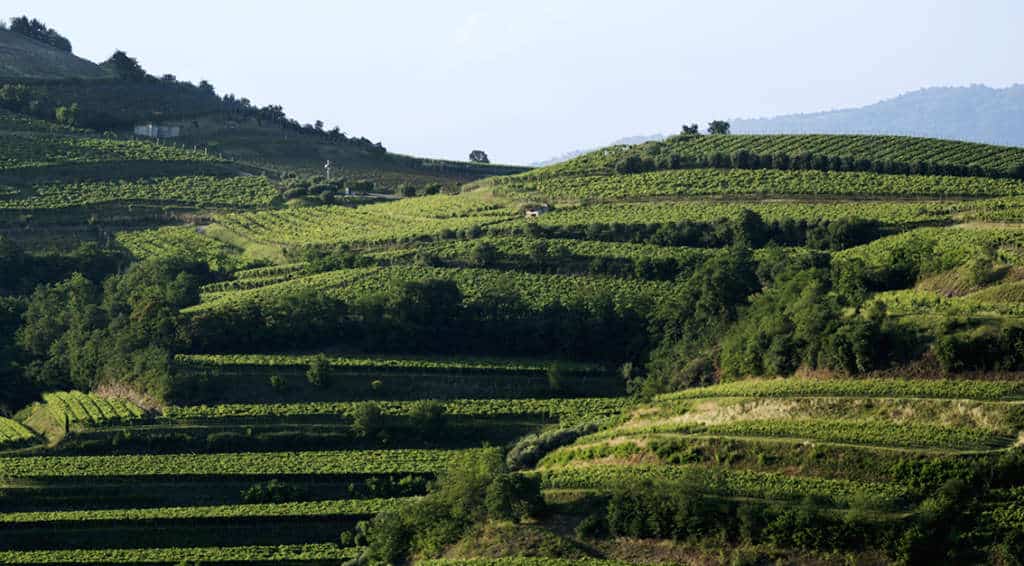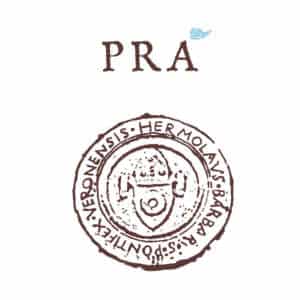About Prà
Even though Vini Prà was founded only in the 1980s, wine has always been in Graziano Prà’s DNA, as he followed in the vine-growing footsteps of his father and grandfather. His family’s vineyards, long-held but never previously commercialized, lie in Monteforte d’Alpone in the heart of Soave in the Veneto region of northeastern Italy. Since that time, he has developed his eponymous winery into one of the top producers of the appellation, and his name is synonymous with the evolution of top quality white wine production in Italy. In 2001, Prà purchased vineyards in the nearby Valpolicella appellation, expanding into red wine production. He has elevated the wines of the Veneto through focused, sustainable work in his vineyards, particularly in the crus of Monte Grande and Monte Bisson in Soave and Morandina in Valpolicella. All viticulture is conducted following organic principles, with the land in Valpolicella certified and in Soave in conversion.
Working the black volcanic soils of Monteforte d’Alpone, Prà produces some of the most interesting expressions of the Garganega variety, defined by their finesse, elegance, and distinctive volcanic minerality. This grape, with its golden bunches, has covered the black hillsides of the region forever; they are the part of the tradition of winemaking here. To preserve the tradition of the region, Trebbiano di Soave is also co-planted. All of his white wines are made from vines with an average age of 30 to 60 years. Characterized by notes of exotic fruit and white flowers, savory minerality, and pronounced acidity, the wines promise great aging potential. Their transparency transmits the power and elegance of this ancient terroir, like the great whites of Burgundy.
Prà was one of the first producers in the area to bottle cru-designated wines, after noting the potential and distinctiveness of certain vineyards sites. His single-vineyard Monte Grande Soave Classico DOC (70% Garganega; 30% of Trebbiano di Soave) was first produced in 1988. The Trebbiano is picked relatively early for freshness, but the Garganega is left on the vine until later in the growing season to concentrate both the juice and the acidity. The wine is then fermented and aged in botti grandi for 10 months and then bottle-aged before release. Later, he added two “Garganega Selection” wines, each with its own unique formula both in the vineyards and the cellar: the Staforte Soave Classico DOC – a selection of choice Garganega bunches from hilltop vineyards, then aged on its lees in tank with bâtonnage for a minimum of 6 months, followed by an additional year of bottle age – and the Colle Sant’Antonio Soave Classico DOC – the richest and most powerful of the wines, made from a selection of Garganega from Monte Grande. The thick skins of the Garganega grape also are ideal for appassimento, and Prà produces a very limited production dessert wine made from dried grapes.
In Valpolicella, in Mezzane and Tregnano, he works with high elevation vineyards at 450 meters on sites rich in limestone. There, he elevates the region’s particular terroir, specifically the tipicity of the cru Morandina, with its heightened mineral, balsamic, and spicy notes, by bringing a white winemaker’s approach to his Valpolicella and Amarone wines. His Amarone della Valpolicella DOCG, a compelling blend of power and finesse with ripe fruit and high-toned aromatics, is made with the traditional varieties of Corvina, Corvinone, Rondinella, Osetela, and others, all first selection dried on racks for two months before destemming, pressing, and vinification. The wines are racked and returned, followed by two years aging in tonneaux and barriques, and a further year in 20hl Allier oak casks once blended. The Valpolicella Ripasso DOC “Morandina” shows plush berry fruits alongside its freshness and lifted aromas. Made from the juice which macerated for five days with the concentrated skins from the Amarone press, the Ripasso spends 12 months in Allier oak casks before release.
The principles that have shaped the Prà story are authenticity and respect for the land, with the aim of producing the purest wines possible. Graziano Prà is still in charge of winemaking decisions and, in the wine cellar, he prefers the exaltation of the fruit, rather that the overreach of the winemaker. He has utilized the best in research and innovation to enhance the high quality of grapes coming from the field. From the beginning, his production choice to only use local vine varieties reflects Prà’s strong belief in the potential quality of local grapes and for the elevation of the territory.



Prà is one my favorite producers in Veneto. These wines all deliver considerable quality for the money.